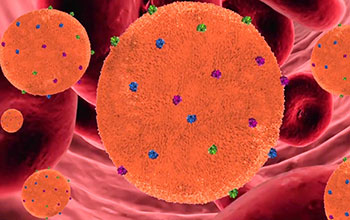Multimedia Gallery
Nanosponge soaks up toxins from drug-resistant infections and poisons (Image 2)
National Science Foundation (NSF)-supported engineer Liangfang Zhang of the University of California, San Diego (UCSD), has created a nanosponge to combat drug-resistant infections like those caused by methicillin-resistant Staphylococcus aureus (MRSA). The nanosponge is made from biocompatible, biodegradable polymer nanoparticles and is camouflaged with a red blood cell membrane. One red blood cell membrane can be used to cloak more than 3,000 nanosponges. In this still from an animation, nanoparticles cloaked in red blood cells circulate through the bloodstream and absorb toxins--anything from bacteria to snake and insect venom. They are designed to work with any type of infection or poison that attacks the cellular membrane. Once the nanosponges are fully loaded with toxins, they are safely disposed of by the liver.
To learn more, see the NSF Science Nation video story Nanosponge decoy fights superbug infections. [Research supported by NSF grant DMR 12-16461.] (Date of Image: 2013) [See related image Here.]
Credit: Jacobs School of Engineering, University of California, San Diego
Images and other media in the National Science Foundation Multimedia Gallery are available for use in print and electronic material by NSF employees, members of the media, university staff, teachers and the general public. All media in the gallery are intended for personal, educational and nonprofit/non-commercial use only.
Images credited to the National Science Foundation, a federal agency, are in the public domain. The images were created by employees of the United States Government as part of their official duties or prepared by contractors as "works for hire" for NSF. You may freely use NSF-credited images and, at your discretion, credit NSF with a "Courtesy: National Science Foundation" notation.
Additional information about general usage can be found in Conditions.
Also Available:
Download the high-resolution JPG version of the image. (547 KB)
Use your mouse to right-click (Mac users may need to Ctrl-click) the link above and choose the option that will save the file or target to your computer.

